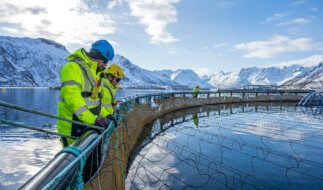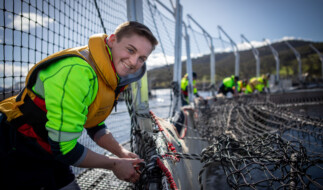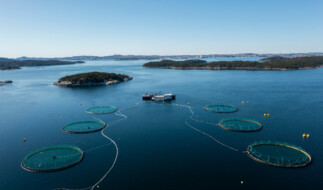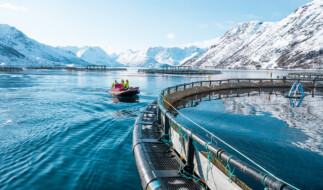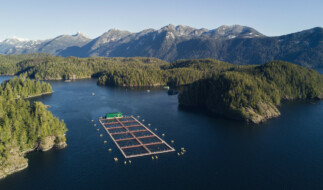Garlic Spiced Salmon with Kachumber, served with Millet Tahari and Red Lentil Dal
Serves: 4
Active Time: 25 minutes
Total Time: 80 minutes
This is a multi-part meal and we recommend trying all meal components together! See detailed recipes below.
Click here to download the full nutrition and environmental analysis
Garlic Spiced Salmon with Kachumber
Kachumber is a refreshing tomato, onion and cucumber salad served in Indian cuisine. In this dish, we serve a garlic and spice rubbed (and responsibly raised) salmon atop the kachumber to complement the richness of the fish and incorporate a serving of vegetables. While this recipe is full of fresh vegetables, you can consider buying frozen farmed salmon as it’s an environmentally-friendly option too. Safely defrost the salmon at home so you know it’s super fresh when you’re ready to cook it. An Oldways recipe and photo, created in partnership with the Global Salmon Initiative.
Active time: 10 minutes
Cooking time: 25 minutes
Total time: 35 minutes

Ingredients
- 1 tbsp canola oil
- 1 lb farmed salmon
- 2 garlic cloves, minced
- ¾ tsp salt, divided
- ¼ tsp tumeric
- 1 ¼ tsp cumin, divided
- 1 medium cucumber
- 2 medium tomatoes, diced
- 1 small red onion, diced
- ¼ cup chopped fresh cilantro
- 2 tbsp lemon juice (half a lemon)
Instructions
- Preheat oven to 425°F.
- Lightly coat a baking sheet with canola oil, then place the salmon on the baking sheet skin side up (to coat the top with canola oil) then flip it over so that the skin side is facing down. Season the top of the salmon with the garlic, ½ teaspoon of the salt, turmeric and 1 teaspoon of the cumin.
- Bake for approximately 15-20 minutes, or until the fish flakes easily with a fork.
- While the salmon is cooking, use a large mixing bowl to combine the cucumber, tomatoes, onion, cilantro and lemon juice. Season with the remaining ½ teaspoon cumin and ¼ teaspoon salt.
- Serve the cooked salmon atop a bed of the kachumber salad.
Sustainability Tip
Zest the lemon prior to juicing and keep some for topping the final dish.
Environmental Footprint
Four servings of this recipe amounts to:
4,083.96 gCO2e
1,165.76 liters water
This Planetary Plate’s total environmental footprint is 4,772.31 gCO2e and 3,457.38 liters water (four servings). For comparison, spaghetti & meatballs with a salad amounts to 21,680.46 gCO2e and 8,561.87 liters of water (four servings).
Millet Tahari
Tahari is a traditional Indian rice dish flavored with vegetables (such as peas, cauliflower, or potatoes) and spices. In this version, we use millet, an ancient grain with a long, rich history in Indian cuisine. Millet is exceptionally sustainable, as it has some of the lowest water requirements of many grain crops and is able to tolerate extremes of heat and drought. To complete your meal, serve the Millet Tahari alongside the Garlic Spiced Salmon with Kachumber and a Red Lentil Dal. An Oldways recipe and photo, created in partnership with the Global Salmon Initiative.
Active time: 15 minutes
Cooking time: 10 minutes
Total time: 25 minutes
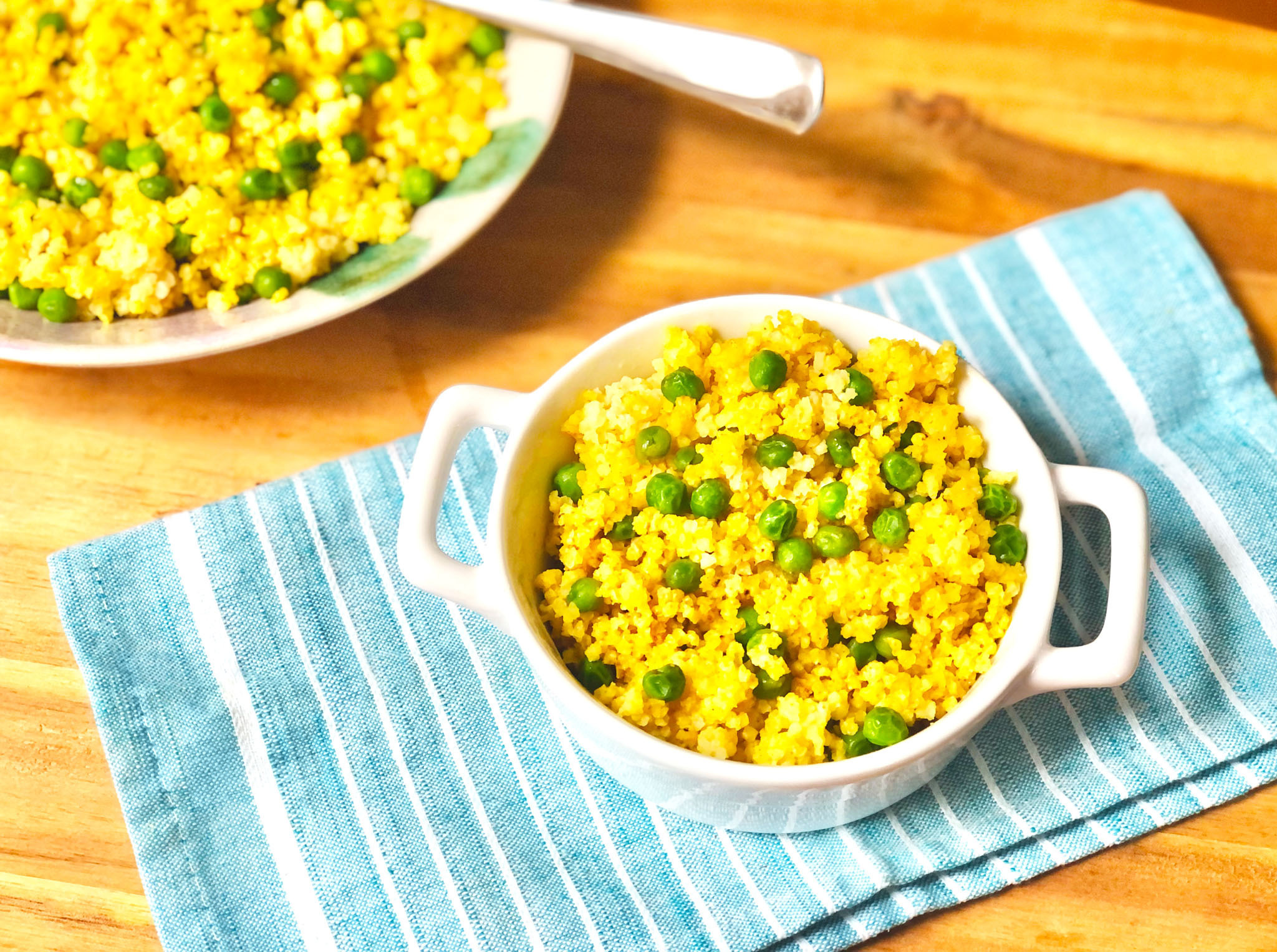
Ingredients
- 1 cup millet
- ¼ tsp salt
- 2 ½ cups water
- 1 tbsp canola oil
- ¾ tsp cumin
- ¼ tsp turmeric
- ¼ tsp garam masala
- 1 cup frozen peas
Instructions
- Combine millet, salt and water in a medium to large pot and bring to a boil. Reduce heat to a low simmer and cook, covered, for about 20 minutes, or until water is evaporated and millet is fluffy.
- When the millet is about halfway done cooking, heat a medium skillet over medium-low heat. Add the canola oil and stir to coat the pan, then add the cumin, turmeric and garam masala. Stir for an additional 30 seconds, until the spices are fragrant. Add the peas and cook, stirring occasionally, until the peas are warmed through, about 5-10 minutes.
- When the millet is done cooking, add the spiced pea mixture into the pot of millet and stir to combine.
Sustainability Tip
Don't forget to use the entire broccoli rabe! Using the whole vegetable (not just the florets), will make sure you get plenty of healthy veg and help reduce food waste.
Environmental Footprint
Four servings of this recipe amounts to:
411.91 gCO2e
941.17 liters water
This Planetary Plate’s total environmental footprint is 4,772.31 gCO2e and 3,457.38 liters water (four servings). For comparison, spaghetti & meatballs with a salad amounts to 21,680.46 gCO2e and 8,561.87 liters of water (four servings).
Red Lentil Dal
A dal is a comforting lentil or pea soup served in Indian cuisine. Tempering spices in oil before adding them to the dal is a traditional Indian cooking technique (sometimes called tadka or chhonk) that enhances the aroma and richness of the dish. You can also feel good about enjoying this dish because lentils are one of the Future 50 Foods recommended by the World Wildlife Fund due to their low environmental footprint and high nutritional value. To round out your meal, serve the dal alongside Millet Tahiri and Garlic Spiced Salmon with Kachumber. An Oldways recipe and photo, created in partnership with the Global Salmon Initiative.
Active time: 5 minutes
Cooking time: 15 minutes
Total time: 20 minutes
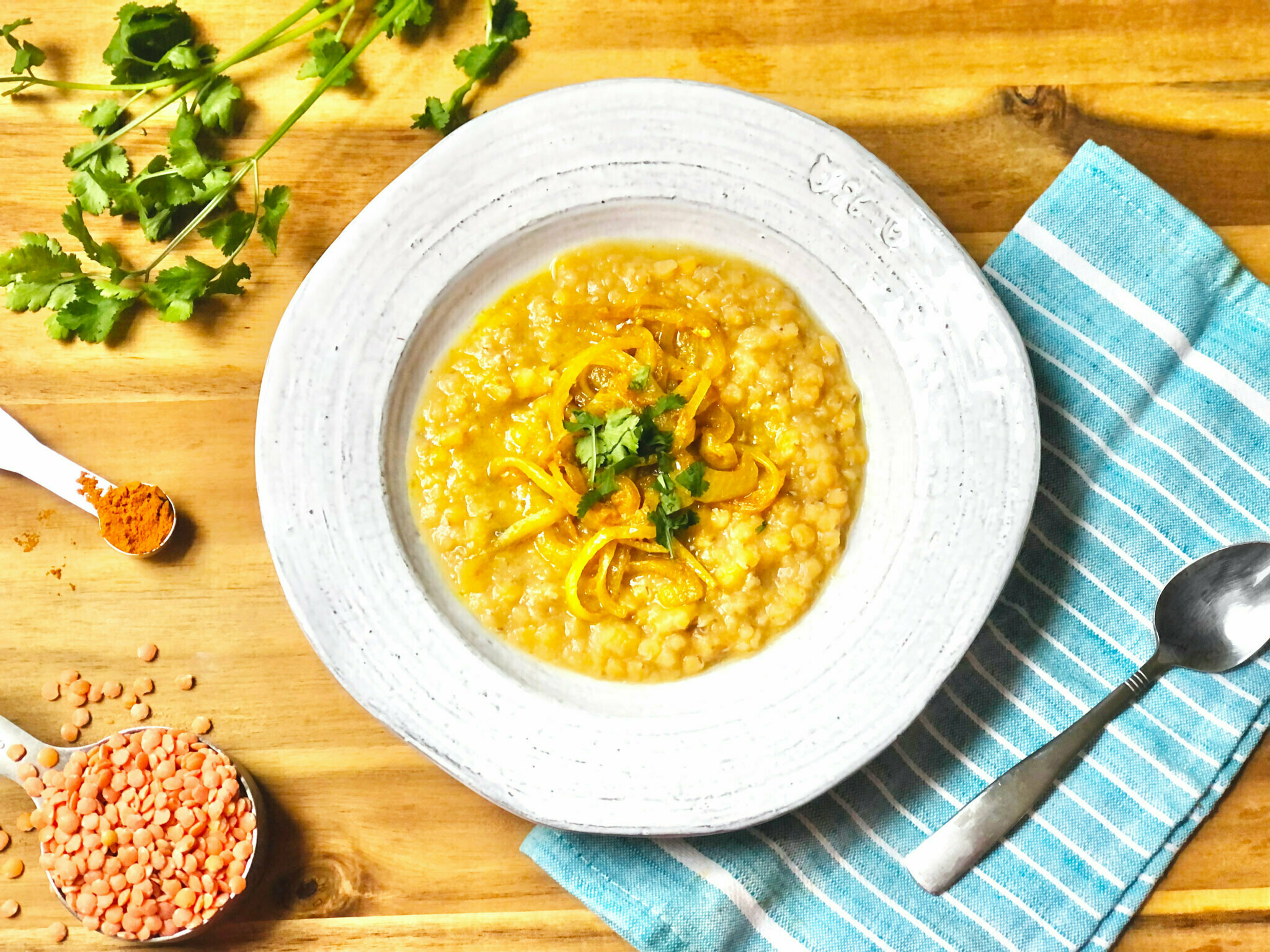
Ingredients
- 1 cup dried red lentils
- ¾ tsp salt
- 3 cups water
- 1 tbsp canola oil
- 1 medium onion, finely chopped
- 1 tbsp finely minced fresh ginger
- 2 cloves of garlic, peeled and finely chopped
- 1 tsp ground cumin
- ¾ tsp ground turmeric
- Optional for garnish: chopped fresh cilantro
Instructions
- In a large pot, add the red lentils, salt and water and bring to a boil. Reduce heat to a lower simmer and cook, covered, until the lentils are tender.
- After about 15 minutes, when the lentils are nearly done, heat a large skillet over medium heat. Add the oil to coat the pan, then add the onion and cook until soft and translucent, about 5 minutes.
- Add the ginger and garlic to the onions and stir for about 30 seconds, until fragrant. Add the cumin and turmeric to the onions and stir for an additional 30 seconds.
- Carefully pour the spiced onion mixture into the dal and stir to combine. Garnish with fresh cilantro before serving, if desired.
Sustainability Tip
N/A
Environmental Footprint
Four servings of this recipe amounts to:
276.43 gCO2e
1,350.45 liters water
This Planetary Plate’s total environmental footprint is 4,772.31 gCO2e and 3,457.38 liters water (four servings). For comparison, spaghetti & meatballs with a salad amounts to 21,680.46 gCO2e and 8,561.87 liters of water (four servings).
